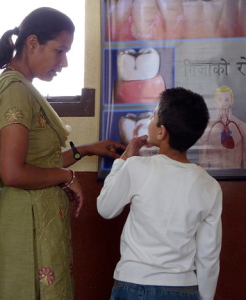Active Listening
Diana Lang
Active listening is a type of communication strategy between two or more people that consists of paying attention to what someone is saying and attempting to understand what is being said. Clinical research studies demonstrate that active listening can be a catalyst in one’s personal growth. For example, children are more likely to listen to themselves if someone else allows them to speak and successfully convey their message. [1]

Learning how to actively listen takes time, practice, and full commitment. Once achieved, it can build a strong foundation for positive communication resulting in a strong caregiver-child relationship by building trust throughout the lifespan. This strategy also tends to improve the quality of conversations by connecting with others on a deeper level, [2] which can lead to more positive and healthy relationships.[3]
How to use this method:
- Caregivers should be on the child’s level and listen in an attentive, nonjudgmental, non-interrupting manner.
- Listeners should pay close attention to possible hidden messages and meanings contained in the verbal communication and should note all non-verbal communication from the child.[4]
- It is important to remember that you are not giving your opinion and thoughts regarding what the child relays to you; you are paraphrasing what the child said and expressing back to the child the emotions the child conveyed.
The Center for Disease Control and Prevention’s website provides useful information about active listening.[5]
- Active listening is paying attention and attempting to understand what someone else is saying.
- It is important to note hidden messages in verbal and non-verbal communications.
- It is important to refrain from giving opinions while paraphrasing what the other person is saying.
- Rogers, C. R., & Farson, R. E. (2015). Active listening. Martino Publishing. Retrieved from https://www.amazon.com/Active-Listening-Carl-R-Rogers/dp/1614278725. ↵
- Hoppe, M. H. (n.d.). Active listening: Improve your ability to listen and lead, first edition. Retrieved from https://www.oreilly.com/library/view/active-listening-improve/9781882197941/xhtml/07_Chapter02.xhtml. ↵
- Rogers, C. R., & Farson, R. E. (2015). Active listening. Martino Publishing. Retrieved from https://www.amazon.com/Active-Listening-Carl-R-Rogers/dp/1614278725. ↵
- Active Listening. (2002). In D. H. Yarn (Ed.), Dictionary of conflict resolution, Wiley. Wiley. Credo Reference: http://proxy.lib.iastate.edu/login?url=https://search.credoreference.com/content/entry/wileyconfres/active_listening/0?institutionId=1110. ↵
- Active Listening. (2019). https://www.cdc.gov/parents/essentials/communication/activelistening.html. ↵

